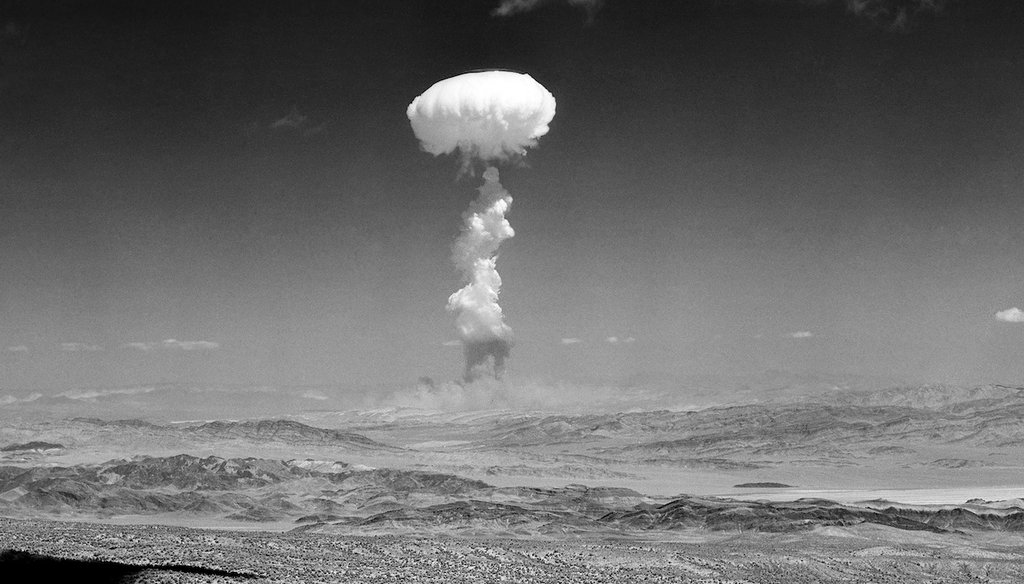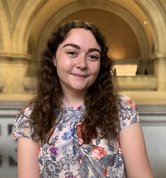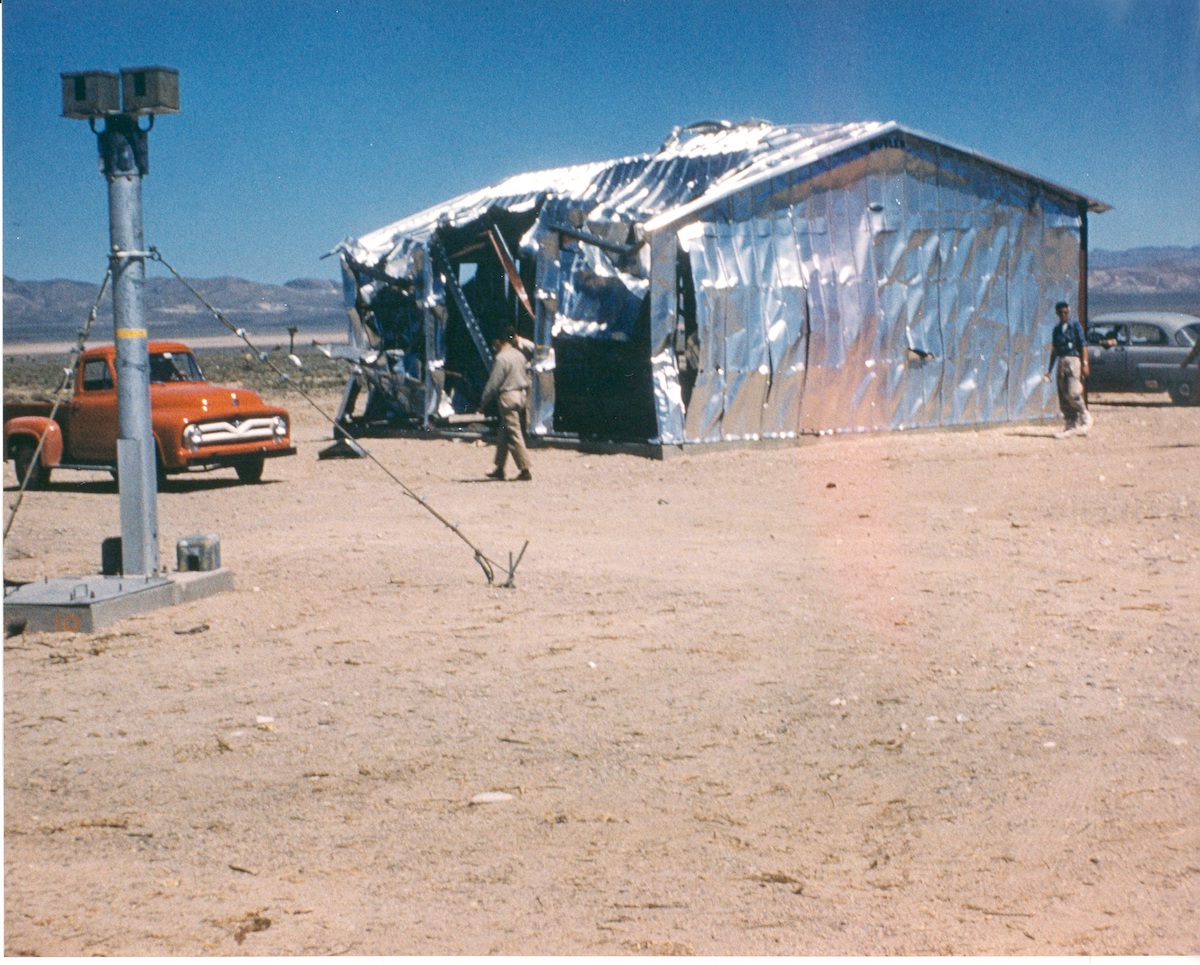Stand up for the facts!
Our only agenda is to publish the truth so you can be an informed participant in democracy.
We need your help.
I would like to contribute

In this April 22, 1952 file photo a gigantic pillar of smoke with the familiar mushroom top climbs above Yucca Flat, Nev. during nuclear test detonation. (AP)
No, this footage doesn’t prove ‘nukes are fake.’ Here’s how cameras filmed past nuclear tests.
If Your Time is short
-
Nuclear weapons testing in the United States has been well documented.
-
In a 1955 test, cameras were placed in metal boxes several thousand feet from ground zero to protect them from the nuclear blast. The cameras were also placed on towers to prevent dust clouds raised by the bomb’s detonation from obscuring the footage.
Seventy-eight years ago, the United States detonated the world’s first atomic bomb in a remote New Mexico desert, ending World War II and sparking the Cold War. But a recent social media post is claiming nuclear weapons are a sham.
A July 4 tweet showed footage of buildings being destroyed in a 1955 nuclear weapons test in Nevada. This blast was part of Operation Teapot, a series of nuclear tests that came a decade after the first atomic bomb exploded. For the test, the U.S. government set up buildings in a remote area and filled them with furniture and mannequins to analyze nuclear weapons’ effects on civilian life.
The tweet, however, questioned how footage of such an extreme event could have been captured.
"It’s weird that the nuclear blasts vaporized brick houses but not the old timey camera recording it," the tweet said. "It’s because nukes are fake. Hiroshima and Nagasaki never had any fall out radiation. The whole narrative and all the evidence is absurd."
The nuclear explosion shown in the tweet demolished buildings in seconds. But the U.S. government, knowing the devastation the bombs would have wreaked, took steps to protect camera equipment so the nuclear tests could be documented.
The U.S., locked in a nuclear weapons race with the Soviet Union, conducted dozens of nuclear tests in the 1950s. The video in the tweet shows a May 5, 1955, test in the Yucca Flat, a patch of Nevada desert about 65 miles northwest of Las Vegas.
For this test, government officials arranged 48 cameras 2,750 feet to 10,500 feet from ground zero, according to a 1955 report on the technical photography of the nuclear test from the Defense Department’s Defense Technical Information Center. All of the cameras were remotely operated, the report said.
Alan Carr, senior historian of New Mexico’s Los Alamos National Laboratory, which was integral to the first atomic bomb’s creation, confirmed to PolitiFact that the cameras used during the nuclear test were placed beyond the blast radius.
The report said cameras were mounted on 10- or 18-foot towers to keep dust clouds raised by the bomb’s blast from obscuring the cameras’ footage. The cameras were also placed inside metal boxes to protect the equipment and the film from nuclear radiation.
This photo shows two cameras mounted on a tower, left, in front of a building destroyed by a nuclear bomb that was tested May 5, 1955, in the southern Nevada desert. (National Museum of Nuclear Science & History)
Some cameras were aimed at the exteriors of structures around the test site, the Defense Technical Information Center report said; other cameras filmed the buildings’ interiors. Varying camera angles and settings were used to document as much of the nuclear blast as possible and to account for potential damage to equipment.
"(Cameras) captured images of the blast on mirrors that were directly exposed to the light and blast," Carr said.
Although the dust cloud the bomb raised obstructed some of the cameras’ footage, the report called the overall results "very satisfactory."
There has been ample documentation of the nuclear tests conducted in the U.S. from 1945 to 1992, with immediate and long-term effects of nuclear weapons well reported. (Nuclear testing worldwide largely stopped after countries, including the U.S., signed the Comprehensive Nuclear Test Ban Treaty in 1996.)
More than 225,000 people in Japan were killed or wounded by the atomic bombs the U.S. dropped over Hiroshima and Nagasaki in August 1945 and the subsequent radiation. Also, reporting has explored the adverse health effects people living close to the nuclear testing sites in Nevada have experienced.
We rate the claim that footage of nuclear explosions proves "nukes are fake" False.
Our Sources
Tweet (archived version), July 4, 2023
Email exchange with Laura Mullane, Los Alamos National Laboratory spokesperson, July 9, 2023
Email exchange with Bernadette Robin, National Museum of Nuclear Science & History spokesperson, July 10, 2023
Defense Technical Information Center, "Project 39.4c – Technical Photography of Physical Phenomena," June 29, 1955
U.S. Defense Threat Reduction Agency, "Operation TEAPOT," September 2021
U.S. Department of Energy, "Atmospheric Nuclear Weapons Testing, 1951-1963," September 2006
YouTube, "Atomic Test In Nevada (1955)," April 13, 2014
United Nations, "End Nuclear Tests Day - History," accessed July 10, 2023
Scientific American, "Nuclear-Testing 'Downwinders' Speak about History and Fear," Jan. 27, 2022
University of California, Los Angeles’s Asian American Studies Center, "Hiroshima and Nagasaki Death Toll," Oct. 10, 2007
PBS, "Atomic Tourism in Nevada," accessed July 10, 2023
History.com, "First atomic detonation at the Nevada test site," Jan. 26, 2021
History.com, "The Trinity Test," Aug. 21, 2018
National Museum of Nuclear Science & History, "Nevada Test Site," accessed July 10, 2023
Browse the Truth-O-Meter
More by Sara Swann
No, this footage doesn’t prove ‘nukes are fake.’ Here’s how cameras filmed past nuclear tests.
Support independent fact-checking.
Become a member!
In a world of wild talk and fake news, help us stand up for the facts.































